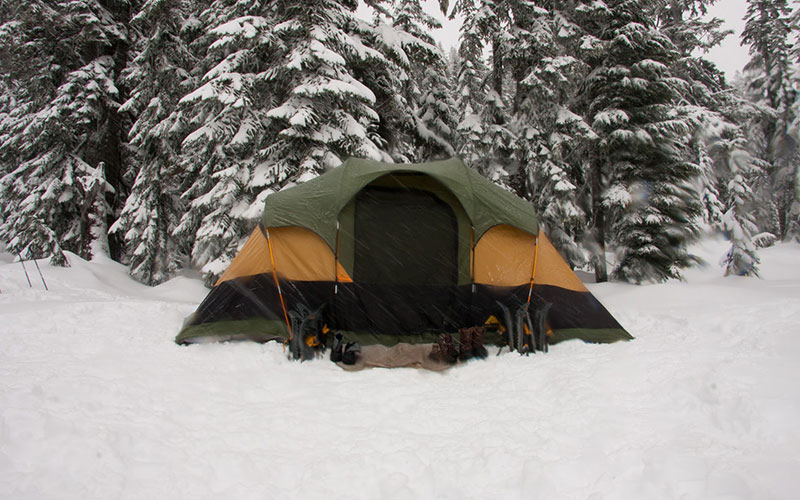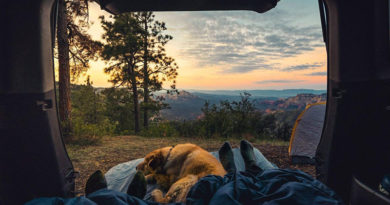Five Important Things To Do For Your Camp Tent As It Gets Colder
Camping is best experienced during winters Not only are you free off mosquito and bug bites in the season, cozying up in nature with a warm cup of hot chocolate is an experience only campers can relate to. With winters approaching, the first thing you need to do is upgrade your tent for it to be able to meet the bitter cold of winters.
This can be done best with proper camp tent insulation as warming the base of where you are sleeping is a key point of warming up outdoors. With a few other tricks and trips that we have prepared in this article, you will be ready for your winter camping trick in no time!
1. Choosing the Correct Tent
The first step to staying warm for winter camping is to choose the correct gear – the most important one being your tent. This highly depends on the environment, and your main job will be to decide between a 3-season and a 4-season tent.
3-Season Tent
3-season tents are the common tents that go into backpacks and are perfect for any treks or campouts during the non-winter seasons.
They are built for good ventilation and are made of more breathable and light-weighted materials. This is not a favorable tent for winters, but you can make do a warm camping experience if the rest of the gear is winter-ready.
4-Season Tent
4-season tents are built to be strong, heavy, and warm. They are made to be used for camping at any time of the year as the strong structure helps the tent to withstand snow.
We recommend a 4-season tent for camping in general as they can be used for all seasons and are stronger, even if they may be on the more expensive side. Getting a smaller-sized tent is also the smarter option as it packs in more body heat.
2. Insulate and Cover Your Tent
Winter can get harsh, which is why it is important to cover your tent well. Getting a tarp, possibly of a dark color, will help keep the heat of your tent inside. The snow is kept out and your tent is also protected from dew and frost.
Remember to cover the top, bottom (both inside and outside), and the walls of your tent well to keep heat from escaping.
The bottom of the tent can also be covered with blankets if you are by any chance, short on gear. Heat always goes towards cold things and a tarp will help block out the sheer cold and the dampness that comes with it.
There are replacements to tarp as well! The following items can be used in cases you do not have a tarp:
- Thermal blanket
- Reflective space blanket
- Plastic
- Snow (A thin layer)
If you go on camping trips often and enjoy the experience, it will be a good idea to invest in down insulation. It will keep your tent warm and cozy overall by trapping the heat inside. However, if you are on a budget, there are other ways to insulate tents.
You can use a fitted tent carpet or your rugs from home to keep on the floor of the tent, like an insulating layer to stop the cold from the ground. Picnic rugs and rag rugs from your home all will work the same.
3. Keep Your Tent Ventilated
Though leaving a gap on your tent entry does not sound like the best idea for camping during winters, it is important for ventilation and to have good airflow.
The hot vapor that arises from our breathing can cause condensation on the cold tent fabric which can freeze.
The ice can also melt later on and cause cold dampness that will be very uncomfortable to sleep in later. Hence, the in and outflow of air is important to maintain.
4. Prepare Your Bed For Winter
When winterizing your tent, remember to get yourself a warm sleeping bag. There
are many different kinds of sleeping bags out there in the market.
But, since covering your nose and head is essential during winters, a mummy sleeping bag is recommended. It circulates all the warmth inside the sleeping bag while also being easy to breathe in.
Other normal sleeping bags can also be warmed up in tons of ways. You can use foam pads and heat packs to keep yourself warm at night. Some people prefer to get a bivvy (special plastic shell for your sleeping bag) to keep the body heat from escaping as well.
In cases when you really do not have anything to keep warm, using trash bags to cover the lower half of your sleeping bag will also help prevent heat loss.
Fair warning, do not breathe or burrow your head into your sleeping bag as it can be dangerous as well as cause condensation which will defeat the purpose of being warm.
5. Extras That Are Useful To Invest In
Since winter can be hard on the body, there are many other things you can invest in that may prove to be useful on your camping trip. Here is a list of a few additional items that you might not regret carrying with you.
- Balaclava (can be used to keep head warm during sleeping)
- Disposable hand warmers / heated gloves
- Thermos (acts both as bottle and heat source)
- Heat packs
- Featherweight quilt (lighter and more efficient)
- Bottle insulator
- Stove (boil snow to keep warm)
- Sleeping bag liners
- Vapor barriers
Pro tip: Even the snow during winters can be used as a free investment for many camping activities. Since drinking water is a limited, sacred item during a camping trip, you can use the snow or ice from frozen lakes around you to make your personal heat packs and hot water bottles and leave the clean water only for consuming purposes. Be careful not to mistake your bottles, though!
Some Tips For Setting Up Your Tent in the Snow
Choose a Good Location
While on a camping trip, setting up your tent is usually the first thing you do, hence it is important to choose a good location first. Following is a list of pointers you need to check on when choosing your tent spot.
- Make sure there is something blocking the wind wherever you are. If the location cannot be helped, consider making a windbreaker using a tarp. Also, make sure you are not camped underneath damaged trees for safety.
- Somewhere with a good water source is a good idea since there can never be too much water to use when camping outdoors.
- Camp on bare ground and stay away from vegetative land to make pitching the tent easier.
- If you are out camping in the snow, remember to stay away from spots that have a high avalanche risk.
- A spot that gets a lot of sunlight is also a good place to choose during winters.
Things to Remember When Setting Up a Tent in Snow

Snow is terrible for camping with its texture and temperature. It is also not the best for pitching tents. Hence, we bring you a few helpful tips for setting up a tent in the snow.
- Flatten out the snow before you set up your tent. Walking around with snowshoes or skis, or stomping in boots can help pat down the loose snow before setting up a tent, it is necessary to do so, as the snow may melt under your body heat when you try to get comfortable inside your temporary home.
- Keeping your tent intact is your first priority, so make sure to do anything to keep the wind out. You can build a wall with snow around your tent or dig out snow a couple of feet down for the tent and vestibule to minimize the force of the wind. Making a vestibule will also help block out wind from one direction of the entrance.
- Instead of using the standard tent stakes, it is better advised to use snow stakes, made specifically for camping in snowy areas. Another cost-effective technique to keep your tent stable and secure is to use stuff sacks filled with snow to keep the tent in place.
It would be terrible if your tent tears down due to odd reasons. Remember to keep away any sharp objects or equipment from the tent to avoid tearing the material. Be careful of the tools like axes, crampons, and ski edges, you use in and around the tent because it will be the worst-case scenario to be stuck in a hail storm tent-less.
If you want detailed information about what to carry trekking for kids, check out our article about How To Prepare for Camping With Kids?
Other Ways to Warm Up
If winterizing your tent does not immediately make you warm enough, there are other things you can do at your camp to help increase your body heat.
Wear Warm Clothes
The correct set of clothes can do wonders in keeping you warm. Always wear a base layer inside before putting on anything. Cotton clothing is bad for camping as it is extremely thin.
Therefore, pick your woolens, socks, gloves, and caps on the basis of how thick they are. Remember to also carry an extra set of base layer clothes as with time, you may get sweaty and the dampness will not be good for the cold outside.
Here are some tips to remember when dressing up for winter camping:
- Do not pick tight-fitted clothes as they may restrict your blood circulation which is important to keep warm. Avoid wearing taut gloves, socks, or underwear to bed as well.
- Do not wear so many layers (or too many thick ones) as being too warm can cause sweating, which will create dampness and will make you even colder than before.
- Dress smart – choose woolens or synthetic fabrics to trap the heat better.
Note: If you are someone who runs warm and sweats easily, you can bring a vapor barrier to prevent your body’s perspiration from reaching your bag.
Consume a Lot of Food and Water
Eating a lot of food and snacking constantly will help keep your body warm. Your body takes up all the calories you consume to keep you warm during winters.
Food with more protein and fat will keep you warm for longer durations of time. time, so consider eating breakfast items and calorie-dense foods that are easy to prepare in a short period.
Since you will most likely be cooking over a fire, try to bring food items that are one-pot friendly. Eat energy bars or snacks during the day and try to reserve hot and heavy meals like stew for dinner.
The same is the case with hydration. Being dehydrated can cause fatigue and mess with your ability to stay warm.
Hence, remember to drink plenty of water. Remember to drink plenty of water to stay properly hydrated. If that is not your thing (because drinking lots of water in winter does not sound very appealing), you can make drinks like tea, soup, or hot chocolate to both feel and stay warm.
Keep Yourself Dry Always
Wearing a lot of layers to keep warm can also often mean that you will be sweating just as much. Make sure that you are dry before you go to bed – especially your feet as a lot of heat can be lost there. Do not bundle up too much before bed and remember – dampness equals coldness!
You can use other sources of heat like a stove or a portable heater, as long as they are used safely. Just make sure that anything that has a chance of catching fire is safely turned off and put away before bed.
Final Thoughts
While camping is technically an outdoor activity and the idea of it is to survive in nature without the help of modern technology, it is not always a bad thing to turn towards the resources we have.
Get the portable heater, space blanket, or whatever other requirements you have to survive in the harsh cold. Camping is a fun and recreational activity and enjoying it is the most essential part of doing it. The warmer you are, the more comfortable and energetic you will be, to go about your traveling and adventuring.



